Type 97 Fighters
Parts 4, 5 & 6
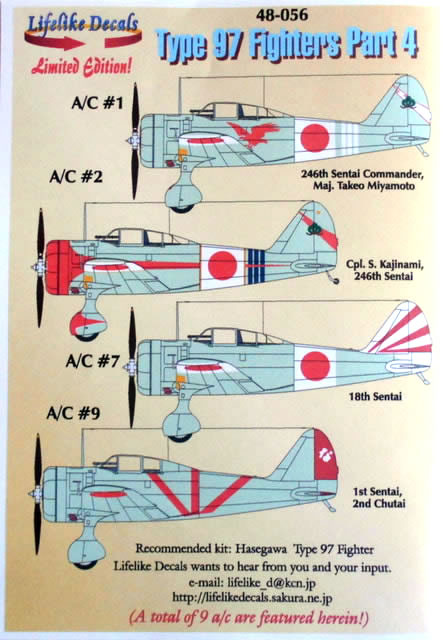
Lifelike Decals, 1/48 scale
S u m m a r y : |
Catalogue Number: |
Type 97 Fighters - Lifelike Decals sets 4, 5 and 6
Item Nos. 48-056, 48-057 and 48-058
|
Scale: |
1/48 scale |
Contents & Media: |
See details below. |
Price: |
Each 1,500 Yen plus shipping available online from LifeLike Decals |
Review Type: |
First Look |
Advantages: |
Excellent quality decals, stunning range of colourful markings and excellent research behind each subject. |
Disadvantages: |
None Noted. |
Conclusions: |
The quality of the decals and the excellent research behind each aircraft leads me to wholeheartedly recommend these sheets to the modeller of this aircraft in 1/48th.. |
Reviewed by Graham Carter

The Nakajima Ki-27 - Type 97 Fighter - was the main fighter aircraft used by the Imperial Japanese Army Air Force up until 1940, although many served until much later than that in this and other roles. Some 5000 of them were produced so they were a pretty ubiquitous aircraft in the late 1930s. These three sets of decals from the Japanese decal company Lifelike Decals will enable the modeller to produce any of 25 different aircraft and are a continuation of their coverage. Decals are designed for the Hasegawa 1/48 kit. I will cover all sheets in this single review to prevent repetition.
Schemes have been chosen to give a representation of the colourful unit and individual markings carried at this time.
All aircraft are painted an overall IJAAF #39 greyish-green with a number of airframes camouflaged on their upper surfaces as noted. Sufficient Hinomaru are provided in various sizes to build three or sometimes four different aircraft from each sheet, although obviously the use of the kit decals will expand your choices. Decals are glossily printed with excellent colour density with only a small amount of carrier film. Register appears to be excellent on the review samples, even for the very finely edged markings which are often a source of misalignment. All sheets consist of the larger one with all of the colourful marks, and a smaller sheet of the main Hinomaru. A small mask sheet is supplied for the cowling markings used to help synchronise the machine guns firing through the propellor, apart from sheet 056 which also includes a mask for the arrows on the fuselage of one example.
Instructions for each aircraft are in colour with some upper views for the camouflaged or specially marked airframes. In addition each aircraft has a detailed description of its scheme, pilot, unit, and any significant action. Each is also referenced and a detailed list of sources is given in the text or at the end of the sheet. These show a remarkable amount of research and add a lot to the history of these airframes. A list of references is given at the end of the sheets. No instructions as to how to apply the decals are given so they must work as per normal.
Although it is not made clear, it appears that the ‘Otsu’ refers to aircraft with clear rear canopies and ‘Kou’ to ones with an enclosed rear to the canopy.
Type 97 Part 4 - Sheet 48-056
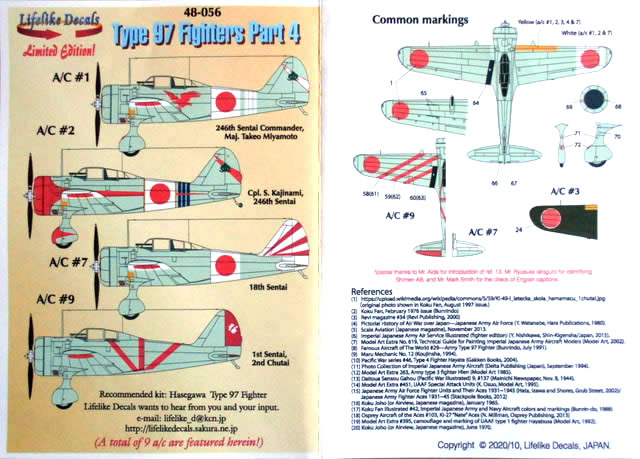
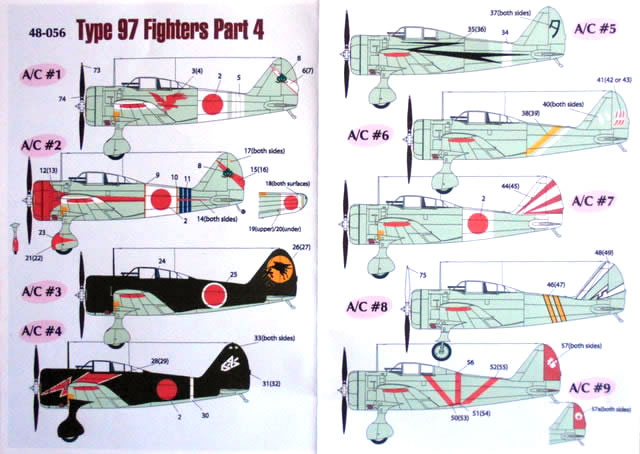
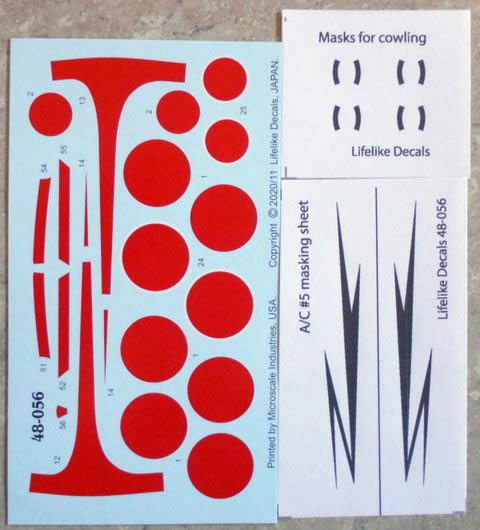
Nine examples:
-
Otsu of the commander of the 264th Sentai, Kakogawa AB, December 1942,
-
Otsu of 246th Sentai, 2nd Chutai, Kakogawa AB, JAnuary 1943,
-
Otsu, some unknown training unit in Manchuria, time unknown, with green upper surfaces,
-
Otsu of the leader of 68th Shinbu-tai, Tenryu AB, March 1945, with green upper surfaces,
-
Kou of 59th Sntai, 1st Chutai, Hankou AB, end of 1939,
-
Otsu of 13teh Snetai 2nd Cutai, Kakogawa, May 1940,
-
? of 18th Sentai, Chofu AB, spring 1944,
-
Otsu of 85th Sentai 1st Chutai, MAnchuria, summer 1942, and
-
Kou of 1st Sntai, 2nd Chutai, Kagimihara AB, July 1938 - May 1939.
Type 97 Part 5 - Sheet 48-057
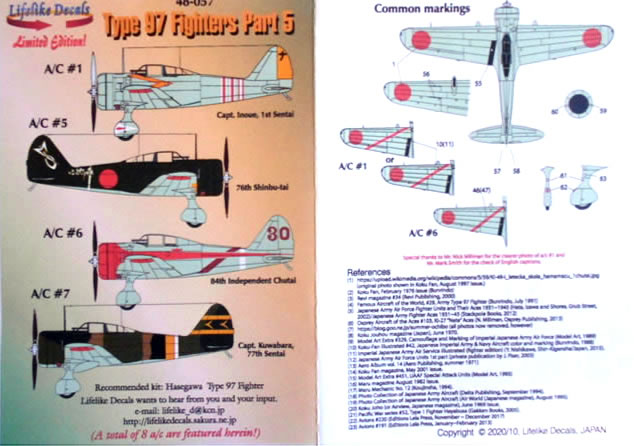 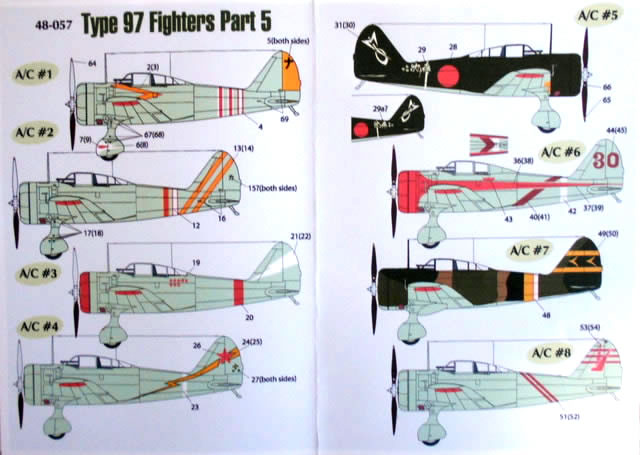
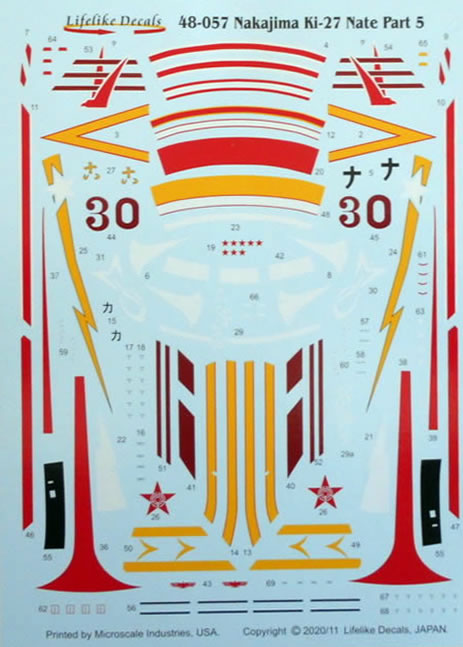
All of these aircraft are Otsu versions except the sixth, as follows:
-
flown by the leader of 1st Sentai, 1st Chutai, Nomonhan AB, China September 1939,
-
flown by the leader of 5th Sentai, 3rd Chutai, Kashiwa AB, end of 1940,
-
flown by the leader of 11th Sentai, 1st Chutai, Nomonhan AB, May-June 1939,
-
of 50th Sentai, 3rd Chutai, Clark AB, Philippines January 1940,
-
of 76th Shinbu-tai, Chirin AB, April 1945,with dark green upper surfaces,
-
a Kou of 80th Independent Chutai, Kwantung, China October 1939,
-
Otsu of the 77th Sentai, 3rd Chutai,Mingaladon AB, December 1941, with irregular dark green and brown stripes on upper surfaces, and
-
of 111th Fighter Training Group, Ryompo AB, Korea, March 1943.
Type 97 Part 6 - Sheet 48-058
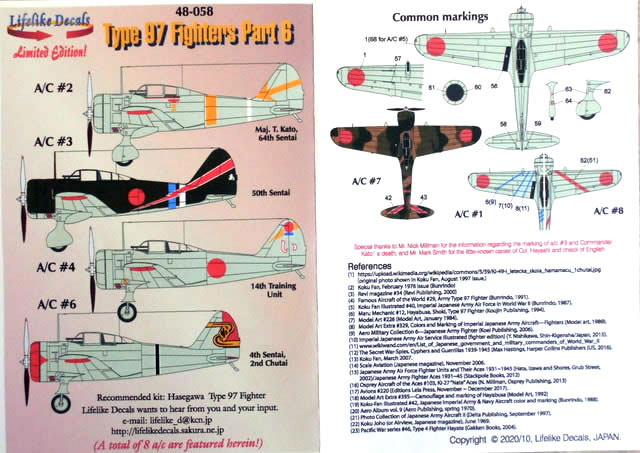
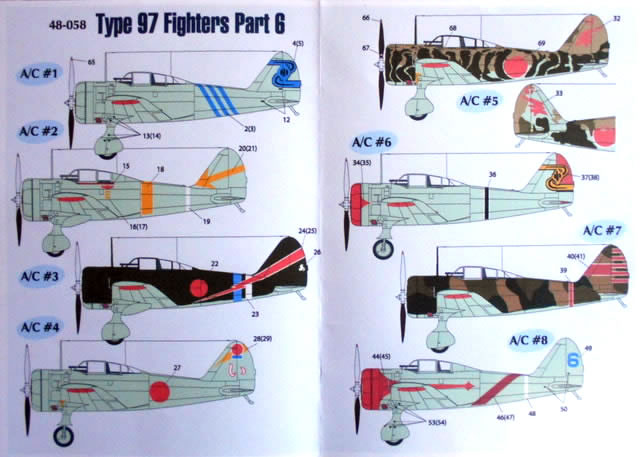
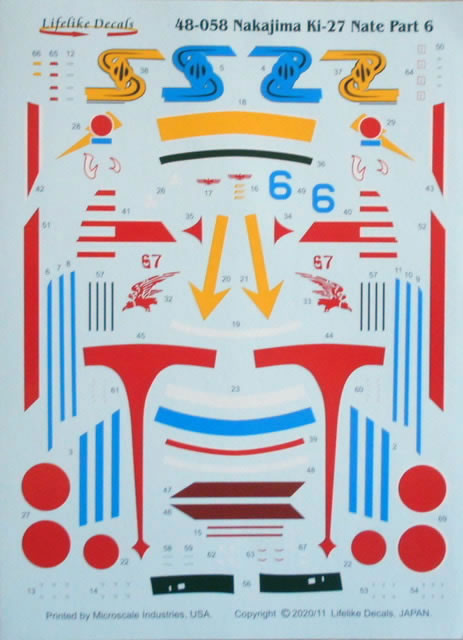
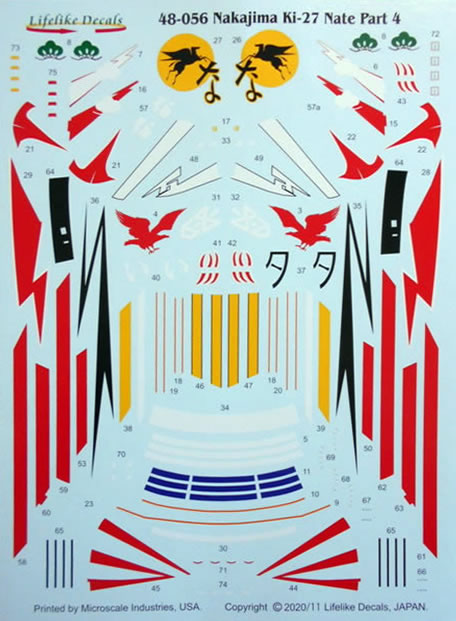
Features the following aircraft:
-
Otsu of the commander of 4th Sentai, Kikuchu AB, September 1940,
-
Kou of the commander of 64th Sentai, Kwantung AB, China, April 1941,
-
Otsu of the leader of 1st Chutai, 50th Sentai, Moulmein, Burma, January 1942, with dark green uppers,
-
Otsu , 14th Fighter Training Unit, Nanyuan AB, China, November 1943,
-
Otsu of unknown Special Attack unit, after war’s end, with irregular dark green and brown stripes on upper surfaces,
-
Otsu of 4th Sentai, 2nd Chutai, Tachiarai AB, end 1941,
-
Otsu of 24th Sentai, 2nd Chutai, Nagilian AB, Philippines, December 1941, with irregular patches of two greens and a brown on upper surfaces, and
-
Kou of the leader of 64th Sentai, 2nd Chutai, Nomonhan, China, September 1939.
The quality of the decals and the excellent research behind each aircraft leads me to wholeheartedly recommend these sheets to the modeller of this aircraft in 1/48th. A sizeable wallet would guarantee a very colourful collection!
A number of modellers would hope to see these in 1/72 as well.
Thanks to Lifelike Decals for these samples.
Text and Images Copyright © 2021 by Graham Carter
Page Created 11 May, 2021
Last updated
11 May, 2021
Back to HyperScale Main Page
Back to Reviews Page |
Home
| What's New |
Features |
Gallery |
Reviews |
Reference |
Forum |
Search